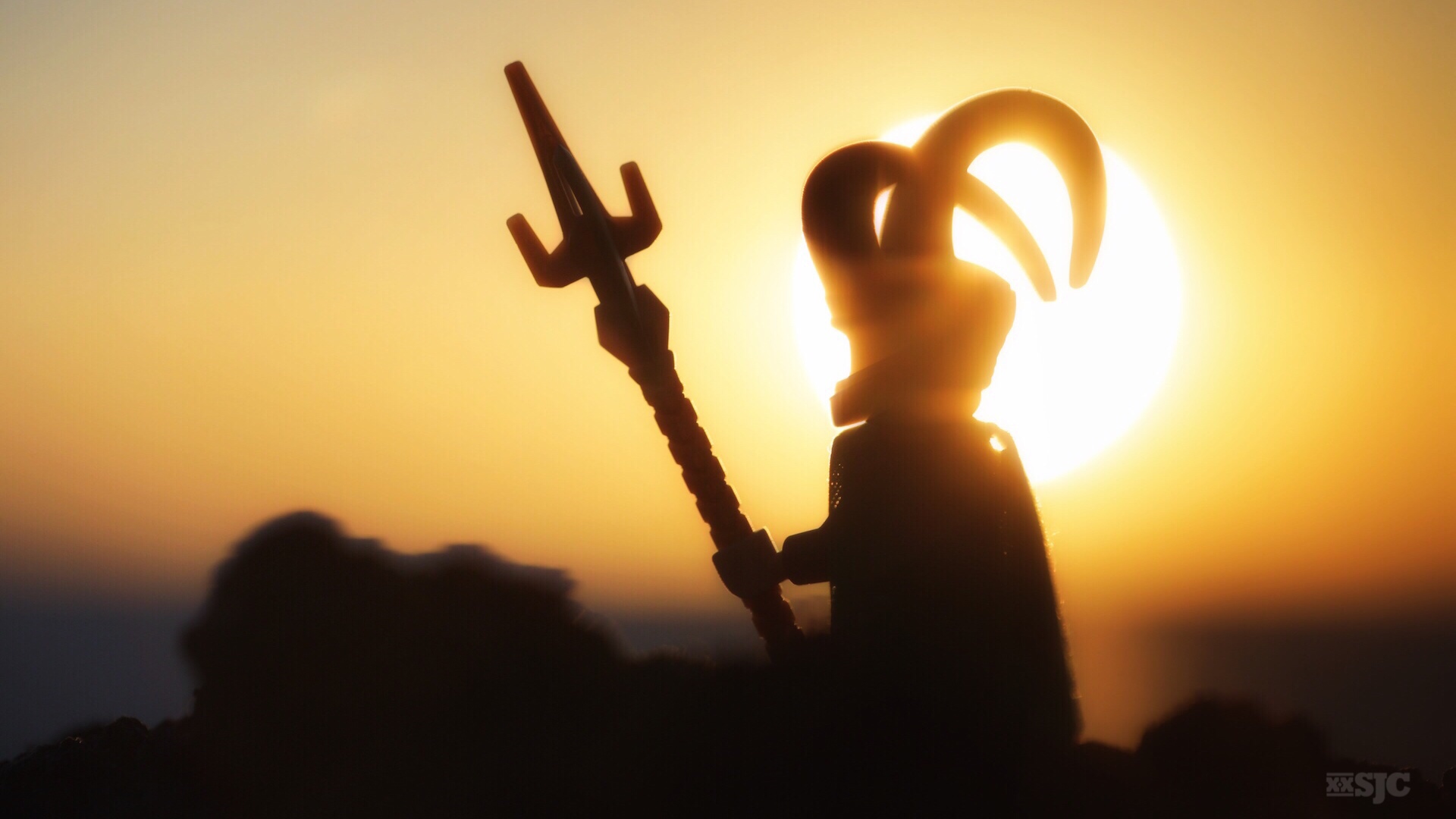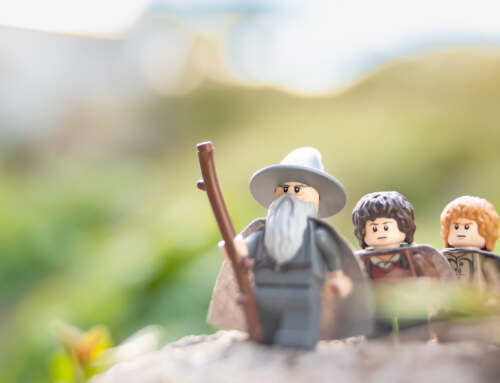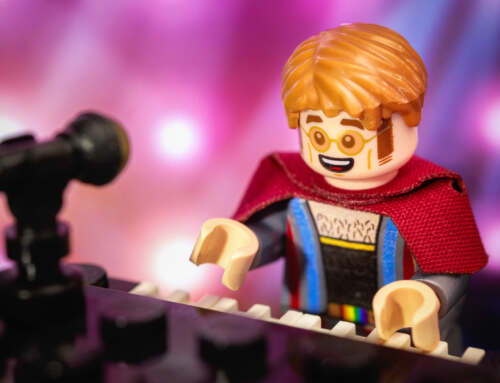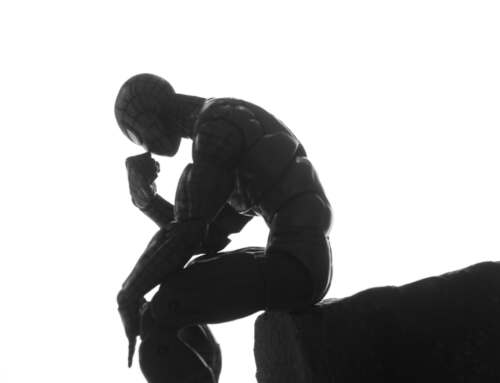“What kind of photography do we do?” has been a question we have been discussing for the last few months here at the Stuck in Plastic collective. We have been asking ourselves “How do we describe toy photography to others?” and “How does toy photography fit into the larger world of photography?” as we attempt to define your collective. After our experience working with a gallery, we now realize how important it is to know the answers to these questions so that we can tell our own story.
In that light we have been working on a manifesto. The discussion has been spirited, many ideas (both large and small) have been considered and a document is under way. But one of the huge sticking points has been what kind of photography do we do? We have considered both still life photography and tableau vivant as two likely contenders, but I am here to propose a third.
In my search for answers and ideas about photography I picked up a new book yesterday: Why It Does Not Have To Be in Focus: modern photography explained by Jackie Higgins. This informative book about photography in the 20th Century breaks down photographs into six basic genres: Portraits / Smile, Document / Snap, Still Life / Freezes, Narrative / Action, Landscapes / Look and Abstracts / Dissolve. Each of these chapters uses a variety of famous and influential photographers to illustrate how these genres, and art photography itself, is being redefined.
First I looked at the chapter on Still Life / Freezes, since it has been a hot topic and the idea that has been favored in our discussions. But one look through the examples given in this book and I see how we don’t fit into this category. As a collective we aren’t referencing traditional still life in our work, we aren’t focusing our cameras on light (and only light) and creating new ways to capture it and we aren’t interested in early photographic processes and how to reinvent / reinterpret them. While we may be staging elaborate scenes to photograph, which look like a still life, it appears there’s more to still life photography than subject matter.
While the chapter on Still Life / Freezes seemed unfamiliar, the next chapter, Narrative / Action, seemed astoundingly familiar.
“This chapter explores the use of storytelling in contemporary art photography, a genre now widely known as “staged photography”. In some cases, the artists set a stage on which they themselves perform; others remain strictly behind the camera and mastermind every detail with a movie director’s obsession. In fact, the scenes constructed in certain photographs owe much to the language and look of cinema: Cindy Sherman borrows from the Hollywood film noir era, and Alex Prager admits to being influenced by the golden age of Hollywood. By contrast, Anna Gaskell looks to classic literature fables, and fairy tales for her inspiration. Other artists mimic and hijack the codes and conventions of established photographic conventions… Jeff Wall has coined the term “near documentary” to describe tableaux artfully staged to emulate reality.” ~ Jackie Higgins
So while the term tableau vivant was suggested by one of our members, it was a term too narrowly defined and too archaic to really help plainly explain what we as toy photographers do. Yet it seems this term, which is clearly covered by Narrative / Action, is probably closest to what we do, we just need to broaden our definition to cover all of the different ways we approach toy photography.
One of the points we diverge upon is whether the toys are alive. (Seriously only a group of toy photographers would even think this was a valid discussion!) It doesn’t matter whether we think our toys are only inert bits of plastic or that we believe they are alive, we are all asking our viewers to believe that they’re alive. The stories we tell are of a narrative quality, we are asking our viewers to believe a story we have created and photographed; we are asking them to interpret the story; we are asking them to ask questions of the image and of themselves. At its best, we are posing a series of questions to the viewer that will engage him or her and create a dialogue.
After reading about these other artists and their intent, I feel that toy photography has more in common with other photographers creating work that is classified as Narrative / Action than Still Life / Freeze.
What kind of photography do you think we do?
~ xxSJC
I realize that this is a pretty esoteric discussion for the average toy photographer. I know that for most of the people in this community the simple act of taking a toy photograph and sharing it with friends is enough. But I also know there are a few like minded people in this community that would like to see their work acknowledged. To make that happen, we have to know who we are, what we do, who we emulate, who we’re reacting against and above all…know the right words to make this understood by both the artistic establishment and the general public alike. This post is one step in that journey.








For me all photography ia about light, and how it form or transform the motive (the scene), with or without toys. I’m so impressed by those photographs that master this genre. And how they create scenes …
I really think that you are right many photographs with toys are staging reality or want to create scenes with toys … I really think you are spot on. I have always seen that genre as one with “living” models, that is people 🙂 but that is my limitation.
Kristina,
When I think of your photos I always think of the light as well. I think it infuses your work and makes it unique. I know if I lived where you do I would be chasing the light too!. 🙂
You’re right when you say that many photographers who practice in the Narrative genre use “live” models, but I think what we offer is an interesting twist when we use toys as our subject. Knowing where we fall in the larger world of photography can help us react and reinterpret this genre. By knowing how to talk about our work can help us to make our work relevant in the larger art community.
Knowing what our personal limitations are is always good. But I think you and I are both committed to moving outside our own comfort zones and seeing where it all leads to in 2016. So far the results have been most interesting!!
S
A great discussion, as we move from playing with toys–as some would see it–to defining our work as a form of art.
My early photos come from a freeze mindset, but now it’s all about action. I capture my toys doing something, even if they’re just still and thinking.
I also see a relationship between what we do and special effects where models (or toys, if you like) stand in for the real actors. I sometimes feel that’s what I do, without adding the suspension of disbelief layer over my photos.
David,
A cinematic mind set is a huge part of the Narrative / Action genre. It is a natural fit and a great source of inspiration for us all! I love that you acknowledge your figures are thinking even when they are still. The joy is when you can convey that feeling to your viewer. Thank you for joining the discussion!
Shelly
Maybe toy photographers play in all six genres of photography and it is the subject we have in common more than the local dialect we speak. As I mentioned before in one of our interesting discussions is that I personally feel more of a Portraits / Smile photographer than a Still Life/Freezes one but I for sure mingle in the Document / Snap category (my early IG images were all of the snap type) and Narrative / Action and Landscapes / Look are for sure two categories I tend to hang out with as well. The one I rarely connect with myself is the Abstracts / Dissolve one.
So maybe we just share the passion for our (plastic) subjects, and the language we choose to speak (any of the six categories) is ever slightly so different and just another tool in our creative narrative, just like the lens we select, the choice of light bender and the post processing we apply.
Hmmm.
Maybe this is all too early for me here.
Still have to finish my first cup of coffee.
Me2
I agree with you here 🙂 what connect us is the fascination of toys, and the wish to use them as motives in our passion for photography 🙂
Boris and Kristina,
Gee I was only trying to find a genre that could be encompassing enough to satisfy you both. I guess I failed yet again.
Shelly
I think you actually managed to create another bridge. One that clearly shows we share more than one language.
I really enjoyed the post !
While I would classify my photography as still life if someone gave me a list of well known genres, I would do it with a lot of reluctance because it seems to me so far and so different from what we do. Since the last post where Kristina talked about still life (can’t remember which one it was) I’ve been thinking a lot about this. I came to think that toy photography has actually a lot in common with cinema. First because lots of toys depict movie character but also I recently realized that I’m myself more inspired by classic movies than by classic photography. And I’m pretty sure that I’m not the only one in our community. So your post is completely spot on for me.
If you find yourself being influenced by cinema and a cinema style, you might want to take another look at the Narrative / Action genre. This genre is clearly related to Narrative photography and many people who practice in this genre are influenced by cinema as apposed to Still Life with takes its cues from painting. Even though the subjects we use are inanimate, like a still life, our purpose it to animate them and bring them to life and tell a story with them. Sounds like narrative to me! Thanks for chiming in! 🙂